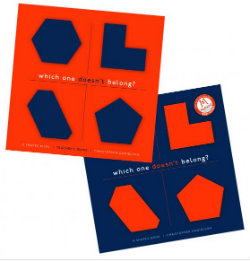Higher Order Thinking with Geometric Shapes
Which one doesn’t belong? A Shapes Book and Teacher’s Guide
By Christopher Danielson
(Stenhouse, 2016 – Learn more)
 Reviewed by Amy Estersohn
Reviewed by Amy Estersohn
Making mathematics meaningful
Which One Doesn’t Belong? comes in two packages. One is a picture book and the other is a teacher companion.
The picture book contains about 200 words about 40 shapes. (For those keeping track at home, that’s about one shape for every 5 words.) The book also explains itself, which makes it ideal for a student to peruse during independent reading or for a teacher in need of a quick activity to pick off the shelf and begin reading to students.
Here’s what the book tells you:
Look at the four shapes on the page.
Think about which one of the four shapes doesn’t belong.
Explain why.

Image credit: Christopher Danielson (author), talkingmathwithkids.com
Simple, straightforward, sophisticated
Looking at shapes is simple. The book’s next steps require participants to develop a theory (“This shape doesn’t belong because it has three sides”) and then test that theory against the other remaining shapes (“Do any of these other shapes have three sides?”) and then explain and defend that theory. Students will also soon realize that there are several answers for all the shapes.
 Differentiation for this activity occurs somewhat naturally. I was able to demonstrate this book with first graders through fifth graders. Each student I shared this book with spent time lost deep in thought among the images, and each student was able to articulate a reasonable explanation of a shape that didn’t belong. What differed among students was the vocabulary that the students chose to express their ideas. For example, a student described the shape on the lower right hand corner of this image as “falling over” rather than using vocabulary like obtuse and acute angles.
Differentiation for this activity occurs somewhat naturally. I was able to demonstrate this book with first graders through fifth graders. Each student I shared this book with spent time lost deep in thought among the images, and each student was able to articulate a reasonable explanation of a shape that didn’t belong. What differed among students was the vocabulary that the students chose to express their ideas. For example, a student described the shape on the lower right hand corner of this image as “falling over” rather than using vocabulary like obtuse and acute angles.
For that reason, this book fits well inside of a mathematics curriculum, either to inspire inquiry into a geometric property or to reinforce vocabulary that has already been introduced.
How much do you know about shapes and figures?
One possible challenge to using this text is implied in the teacher’s guide. If you wish to run a “Which one doesn’t belong?” conversation with students in which you introduce mathematics vocabulary and concepts, you should be polished in your precise definitions of concepts like concave, convex, and vertex, because some of these images are designed to push and prod at mathematical definitions. For example, does a triangle have to have three straight sides for it to be a triangle? What if the sides are wiggly? (Technically, yes.)
Easy access to rigorous mathematical definitions and careful advance planning of the images will help teachers resolve student debates quickly and show the importance of precise language. I would encourage teachers who aren’t as familiar with rigorous definitions in geometry to collect the student questions that arise as a result of this activity and research them with students later.
If that research is too much for teachers, Danielson provides an “answer key” in the back of the teacher’s guide in which he places a variety of authentic student responses from a variety of age groups.
Join an online community for new ideas and inspiration.
Which One Doesn’t Belong? is more of a conceptual device than a book that students and teachers can return to multiple times throughout an academic year. There’s an active Twitter hashtag with real-world user-generated images at #wodb as well as a curated collection of images and activities at http://wodb.ca/ (The publisher is now offering posters featuring shape sets, opening up additional possibilities.)
I hope this movement of mathematics discussion continues to grow.
Amy Estersohn is an English teacher in New York. Her Twitter handle is @EnglMsE.


































